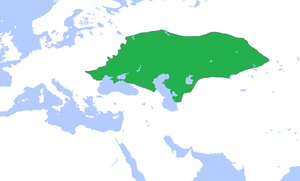Simsir

Simsir was a principality in Central Eastern Chechnya in the Middle Ages, existing in the twelfth, thirteenth and fourteenth centuries. It was located roughly in Eastern Chechnya (Ichkeria,[1] roughly where the modern districts of Gudermes and Nozhay-Yurt lie today, around the Sunzha and Terek rivers.[2] Its name may have been derived from the Chechen town of Simsir.[3] It was a rather small state; the southern parts of Chechnya and Ingushetia were ruled by Durdzuketia, while the northwestern parts of the Vainakh area belonged to Alania. Simsir originally also had lands in Southeast Chechnya, but over the course of its existence, it became more and more focused on the Sunzha river as the core of its statehood. Its society had a feudal hierarchical social structure,[4][5][6] and in its later years it allied itself with the Golden Horde before it was destroyed in 1390 by Timurlane, with that conquest of Timurlane written about in the Zafarnama by Sharaf ad-Din Ali Yazdi.
Society
Simsir existed at a time when Chechens had a feudal system; in the early modern era, they overthrew their feudal rulers in a "revolutionary" event and established in its place a quasi-democratic tukkhum-taip system by which representatives of teips voted in a national council [7] but while this differentiated Chechens from their neighbors more recently, it was not the case in the Middle Ages when Simsir existed.
In the Middle Ages, Chechen societies such as Simsir had a hierarchical and pyramidal structure. The Principality of Simsir's prince (the eela) sat at the top, followed by nobility and vassals (uzden), followed by free commoners (halxoi), followed by servants (yalxoi, including gharbashash, i.e. bond women), followed by serfs (lesh, lai in the singular), with only slaves and war captives (yiisarsh) beneath them; additionally, clerics were placed in the uzden nobility class.[5][6] The wife of a prince was called a stuu and addressed as stulla.[8]
Alliance with the Golden Horde

In the 14th century, its rulers became tributaries of the Golden Horde, and converted to Islam; because of this alliance, it was later attacked by Timurlane.[9] The time of tribute to the Golden Horde is thought by Amjad Jaimoukha to be the origin of the custom of `amanat, whereby the children of nobles were given as pledged hostages. Such children were sent to the Khanate's court, where they learned the Mongol language, and they could be put to death or enslaved if the Golden Horde desired. This custom later became associated with the giving of hostages to cement pledges across the North Caucasus.[10]
Destruction by Timurlane
In the reign of its last ruler, Gayur Khan, the Principality of Simsir was destroyed by Timurlane in 1390 as part of his campaign against the Golden Horde. Its population fled south, into the mountains, in order to escape the attacks of the Mongols.[11] In the Zafarnama it states that Timurlane chased these escapers south into the mountains and subdued them.[12]
References
- ↑ Гадло А. В. Этническая история Северного Кавказа X—XIII вв. — СПб. : Изд-во С.-Петербург. ун-та, 1994. — с. 236 — ISBN 5-288-01010-2
- ↑ Jaimoukha, Amjad. The Chechens. Page 34
- ↑ Сигаури И. М. Очерки истории и государственного устройства чеченцев с древнейших времен. — М. : ИД «Русская жизнь», 1997 — с. 365
- ↑ Айдаев Ю. А. Чеченцы: история и современность. — М.: Мир Дому Твоему, 1996. — 351 с. — ISBN 5875530057
- 1 2 Jaimoukha, Amjad. The Chechens: A Handbook. Page 89
- 1 2 Akhmadov, Ya. Z. Istoriya Chechni s drevneishikh vremen do kontsa XVIII veka [The History of Chechnya from Ancient Times to the End of the 18th Century]. Moscow: Mir domu tvoemu, 2001.
- ↑ Jaimouhka, Amjad. The Chechens: A Handbook. Page 89
- ↑ Jaimoukha, Amjad. The Chechens : A Handbook. Page 276
- ↑ Jaimoukha, Amjad. The Chechens. Page 34.
- ↑ Jaimoukha, Amjad. The Chechens. Page 137
- ↑ Jaimoukha, Amjad. The Chechens. Pages 35-36
- ↑ Sharaf ad-Din Ali Yazdi (2008). Zafar Nama (Book of the victories of Amir Timur, translated from Persian to Uzbek by Muhammad Ali ibn Darvesh Ali Bukhari (16th century)). Tashkent: Academy of the Sciences of the Republic of Uzbekistan. "Abu Rayhan Beruni" Institute of Oriental Studies. SAN'AT. p. 203.